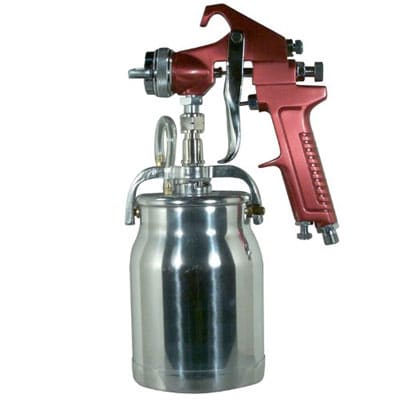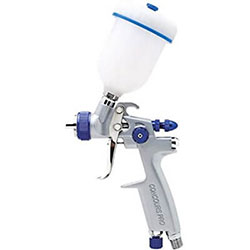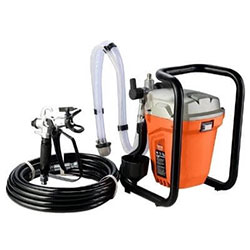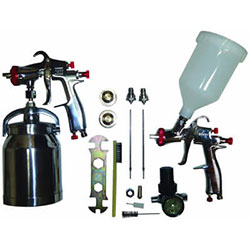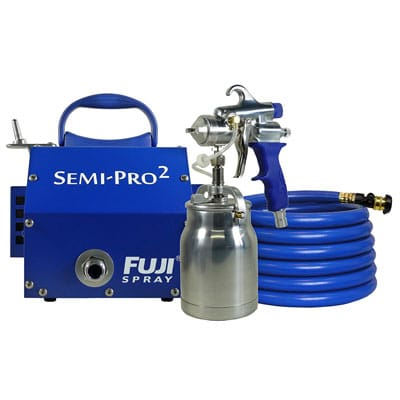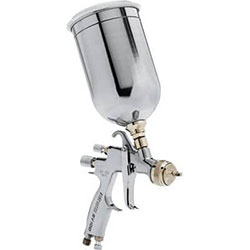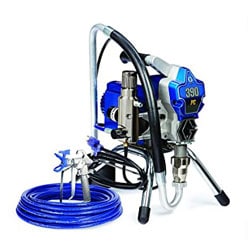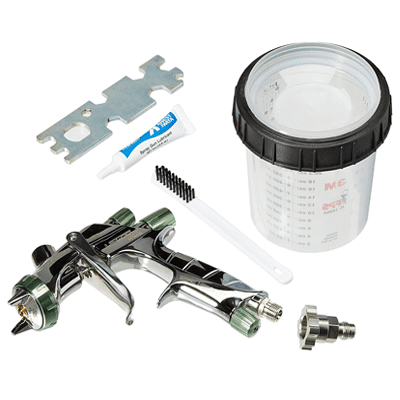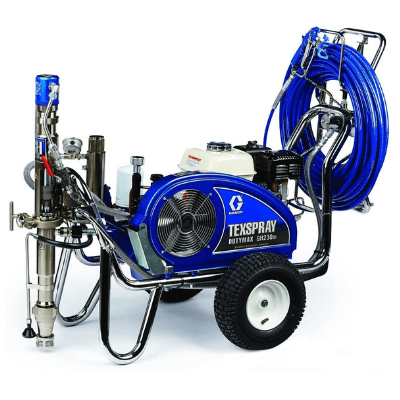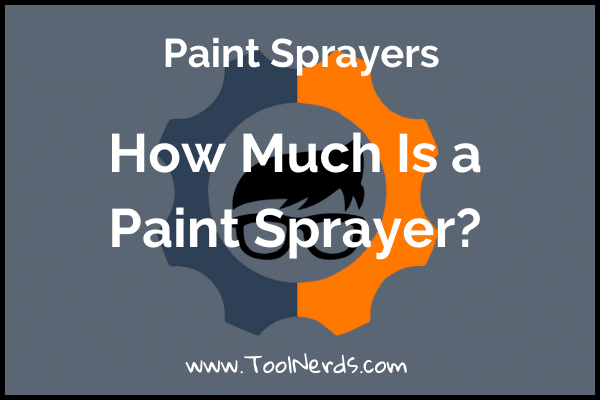
Your Guide to How Much Is a Paint Sprayer
- Features Wagner’s versatile iSpray and Detail Finish tips.
- Easy-connect hose couplings.
- Can deliver thin and dense mediums.
Product Comparison Table
| IMAGE | PRODUCT | DETAILS | ||
|---|---|---|---|---|
|
Best Paint Sprayer Under $50
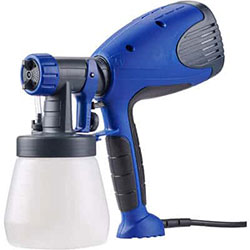
|
Best Paint Sprayer Under $50
|
Features
|
Check Price at Amazon | |
|
Best Paint Sprayer Under $100
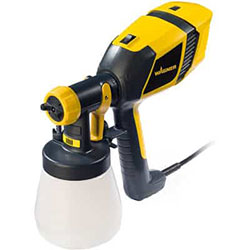
|
Best Paint Sprayer Under $100
|
Features
|
Check Price at Amazon | |
|
Best Paint Sprayer Under $150
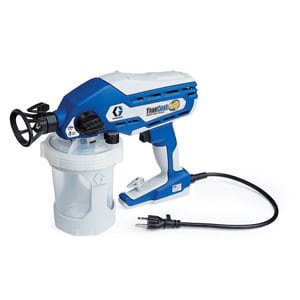
|
Best Paint Sprayer Under $150
|
Features
|
Check Price at Amazon | |
|
Best Paint Sprayer Under $200
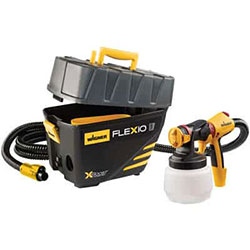
|
Best Paint Sprayer Under $200
|
Features
|
Check Price at Amazon | |
|
Best Paint Sprayer Under $500
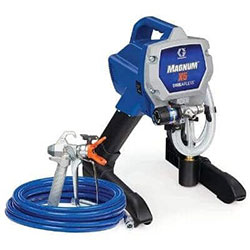
|
Best Paint Sprayer Under $500
|
Features
|
Check Price at Amazon | |
|
Best Paint Sprayer Under $1000
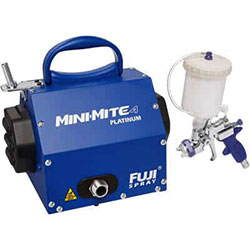
|
Best Paint Sprayer Under $1000
|
Features
|
Check Price at Amazon | |
|
Best Paint Sprayer Over $1000
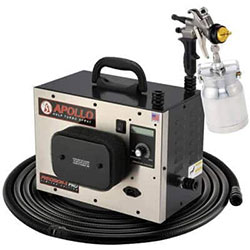
|
Best Paint Sprayer Over $1000
|
Features
|
Check Price at Amazon |
How Much Is a Paint Sprayer? — The Ultimate Price Guide to Power Painters
The truth is, the paint spray gun price varies across makes, models, and formats — ranging from little more than an evening out at your favorite restaurant up to the cost of a small family car.
This guide pulls back the curtain and reveals how easy or tough the best sprayers are on your pocket — and what you can expect to receive in return for your hard-earned dollars.
How Much Are Paint Sprayers? — The Cost-Affecting Factors
Not much help, is it?
You see, the cost of an individual power painter is based on an absolute plethora of factors, including the durability, design, capabilities, and target market of the machine. And, more expensive doesn’t necessarily mean a better sprayer — there’s little point in spending half a year’s salary on a contractor-grade unit if all you’re going to use it for is staining some bookshelves.
So, to make the price points easier to comprehend — and to ensure you select the consummate machine for your needs — here are the main (non-exhaustive) features that affect the unit’s cost.
Brand
Unsurprisingly, the more recognizable the manufacturer’s marque — the more costly the sprayer will be. In the power-painting niche, this is the big-boy brands of Titan, Earlex, Wagner, Fuji, and Graco.
For example, take the awesome Wagner 2000. This versatile DIY-focused power painter is similarly specced to the budget Meterk (who?) HVLP gun — yet is three times more expensive.
However, don’t fall into the trap of thinking that machines that simply share the same features are equal.
With the major industry-players, you’re getting more than just knobs and dials. These spray painting specialists deliver units that are built to withstand intense use, provide helpful customer support via telephone and email, and manufacture products that include extensive warranties.
Furthermore, as these brands typically concentrate only on the spray painting niche — they’re able to provide a mammoth catalog of spare and replaceable parts for your gun. This isn’t the case with bargain-basement units, where, once they break down usually need to be thrown into the trash.
Format
Paint sprayers come in three main formats — turbine, airless, and pneumatic.
Typically, due to the technology involved in their manufacturer — fans or hydraulic pumps — turbines are lighter on the pocket than airless machines for the same target market. To see the relative benefits of each of these spraying types, check out my Air Vs Airless face-off.
However, pneumatics are a little more challenging to price categorize — as they cannot be used straight-outta-the box. While these guns can be picked up for as little as $20 — they also require the purchase of a high-pressure hose and an electric or gasoline-powered compressor.
Target Market
Casual Use/Budget Sprayers
As the name suggests, this area features paint sprayers for the low-frequency, home user that may not use their machine more than a few times per year. As the most price-friendly units on the market — they’re usually available for $60 or less. Examples include the Meterk HVLP and the Rexbeti 750.
However, as low-intensity machines, they lack the durability and robustness for anything more than intermittent use. Furthermore, it’s impossible to find anything other than handheld turbines in this category.
DIY Sprayers
Slightly more costly than the casual use units — around $60-$150 — the DIY niche is the most competitive arena in power painting, and includes pneumatic, airless, and turbine models.
These machines have the durability to cope with frequent DIY weekend use, have more user-tailorable features than the budget sprayers, yet remain straightforward to operate.
While the category is dominated by the mighty Wagner SprayTech — with its flagship FLEXiO 3000 — other big-names make some impressive home-improvement units, such as the HomeRight Finish Max and the Graco TrueCoat.
Prosumer Sprayers
This is the area where amateur spraying becomes serious business. Prosumer units — generally in the price range of $150-$450 — are machines that attempt to bridge the gap between DIY and trade-grade models.
As such, the turbines and airless machines can cope with more intense use than standard DIY sprayers, generally include a pro-standard gun or nozzle, and typically boast accurate power control. Pneumatic prosumer guns often feature LVLP and HVLP tech, include variable air and material flow control, and often arrive with an inline regulator and gauge.
Examples include the hydraulic Graco X5, the HVLP Wagner 5000, and the compressor-driven DeVilbiss FinishLine.
Professional Sprayers
If you have the cash — then you can own one of the ultimate painting machines in the spraying arena.
Starting around $500 for a turbine or airless example, these units are true workhorses. Possessing the durability and throughput rating to be used all day, every day — they’re the go-to machine of the trade contractor.
In addition to higher power settings than prosumer models, versatile user-controllability, and often boasting a floor-stand or cart — these sprayers often feature rapid-replacement pumps and filters together with reversible tips to reduce time-costing downtime. Furthermore, with access to a wide catalog of replacement parts — they can be upgraded or modified to suit the user-specific requirements.
Although you can pick up a solid and reliable pro unit for $500 — that’s just the beginning, as costs escalate significantly as features increase. For example, an LCD-controlled unit such as the turbine-driven Apollo 5 Precision is as hard on the wallet as a holiday to Europe. And the gasoline-powered airless Graco GH230 is the same cost as a compact automobile — possibly making it the most expensive spray gun on the market.
User Tailorable Features
That said, within each user-category, these specifications vary, which has an impact on price. Hence, expect to shell out more dollars for airless and turbine units that incorporate one or more of the following features:
- Choice of spray patterns.
- Variable material volume flow.
- Adjustable turbine or hydraulic pump output.
- Spray width control.
- Variety of tip sizes.
- Multi-capacity paint containers.
Paint Sprayer Prices — The Best Machines in Each Cost Range
To save you time comparing brands, costs, functions, and specs — I’ve curated the ultimate machines across the main price bands below. Where possible, I’ve tried to cover every model format — airless, turbine, or pneumatic — for each cost range, although bear in mind there are exceptions. For example, you can’t purchase an airless unit for less than $50 — hence, no model is included.
The Best Sprayers Under $50
- Lock-No-Go system for rapid dismantling.
- Choice of three spray patterns.
- Cord protector to extend longevity.
- Design
- Functionality
- Price
Our Rating: 4.3
- 50-60 PSI output.
- Lightweight.
- Requires a small compressor — just three horsepower.
- Design
- Functionality
- Price
The Best Sprayers Under $100
- Extensive warranty.
- Fatigue-preventing handle.
- Three spray fan pattern choices.
- Design
- Functionality
- Price
Our Rating: 4.3
- Durable forged and anodized body.
- Trademarked ‘air curtain’ prevents overspray.
- Lightweight at just 0.6 pounds.
- Design
- Functionality
- Price
The Best Sprayers Under $150
- A powerful unit that offers straightforward operation.
- Ground-sitting turbine — reduces handheld weight.
- Aluminum and acrylic cups included.
- Design
- Functionality
- Price
Our Rating: 4.3
- Two tips — for wide and narrow spray delivery.
- Reversible tip permits straightforward blockage removal.
- Stainless steel pump for longevity.
- Design
- Functionality
- Price
- Arrives complete with a cleaning kit.
- Pro-grade gun but at a DIY price.
- Adjustable air and material flow control.
- Design
- Functionality
- Price
The Best Sprayers Under $200
Our Rating: 4.8
- Turbine casing doubles as a storage container.
- Two spray fan settings.
- 11.5-foot hose.
- Design
- Functionality
- Price
Our Rating: 4.3
- 25-foot hose.
- 0.625 horsepower hydraulic pump.
- Trade-grade gun with reversible tip.
- Design
- Functionality
- Price
- Two paint cups — 0.625 and 1.06-quarts.
- Gravity feed and siphon feed containers.
- Adjustable fan width from 7-10.9 inches.
- Design
- Functionality
- Price
The Best Sprayers Under $500
Our Rating: 4.8
- Includes cleaning brush and viscosity cup.
- Robust metal turbine housing for hardcore use.
- The case features a storage stand for the gun.
- Design
- Functionality
- Price
Our Rating: 4.3
- 0.5 horsepower hydraulic pump.
- User-controllable pressure settings.
- Lightweight for an external-drive airless — just 13 pounds.
- Design
- Functionality
- Price
- Low density and high viscosity compatible.
- Durable and robust for extreme use.
- Easy-turn dials.
- Design
- Functionality
- Price
The Best Sprayers Under $1000
Our Rating: 4.8
- Award-winning T75G gravity gun with 1.3 mm tip.
- 0.63-quart paint cup capacity.
- Made in Canada.
- Design
- Functionality
Our Rating: 4.9
- 50-feet of non-kinking hose.
- Trade-level property renovation sprayer.
- Speedy-clean QuikAccess feeding valve.
- Design
- Functionality
- Price
- Low-volume delivery to reduce overspray, dripping, and pooling.
- Complete with a gun wrench and cleaning brush.
- Ideal topcoat and clear coat spray gun.
- Design
- Functionality
- Price
The Best Sprayers Over $1000
Our Rating: 4.5
- Incorporated gun-docking system.
- Extensive five-year warranty.
- Three spray fan patterns.
- Design
- Functionality
- Price
Our Rating: 4.4
- Cart-mounted on heavily treaded pneumatic tires.
- 100-foot hose.
- Massive 1.55 gallons per minute delivery.
- Design
- Functionality
- Price
How Much Is a Spray Paint Gun Conclusion
So, how much is a paint gun?
The answer is, as much as you’re happy and willing to pay.
Ranging from sub-$50 units through to sprayers that cost over $7k, there’s a machine that not just suits your pocket, but also your skill level, project requirements, and size constraints. And while all the sprayers in this article exemplify the best units at particular price points — there are three machines that I believe deserve a particular mention.
The budget-level HomeRight Quick Finish is highly affordable and straightforward in operation — yet still promises a pleasing finish combined with reliability. For DIYers who have aspirations to ‘go-pro’, there are few more impressive sprayers than the airless Graco X5. And for the true tradesperson, the ProConnect 390, with its rapid delivery and downtime saving pump replacement is a real contractor workhorse.
If you’ve found this How Much Is a Paint Sprayer article useful and informative, please feel free to share it with your buddies!
How Much Does a Paint Sprayer Cost FAQs
Q: Is a Paint Sprayer Worth It?
Yes. A paint sprayer delivers the coating medium up to ten times faster than a brush, and with fine atomization, it provides a more pleasing coat that’s free from brushstrokes and lost bristles.
Q: What Is a Typical Paint Gun Price?
You can pick up a good quality, casual use DIY machine for around $50 — such as the HomeRight Quick Finish. However, prices range from this starting point to the 1000s of dollars — depending on the features, throughput rating, build quality, and brand.
Q: How Much Is a Paint Gun for Cars?
For automotive bodywork, you need a pneumatic HVLP spray gun — such as the Eastwood Concours Pro. You’re looking for a gun that offers low overspray, combined with the ability to deliver both dense primers and thin clears. For a high-quality unit — expect to pay between $100-$200.
Q: Are Airless Paint Sprayers Expensive?
You can buy a budget airless unit, such as the Himalaya Power Painter, for less than $200. For prosumer-grade sprayers, like the Graco X5, prices range from $200-$400. Generally speaking, airless machines are harder on the pocket than comparable turbine examples.
Q: How Much Is a HVLP Sprayer?
You can buy a quality HVLP turbine machine for around $50-$100. HVLP pneumatic guns are similarly priced — but remember they involve the purchase of an additional compressor to run the unit.
Q: Should I Buy a Used Paint Sprayer?
If you don’t know and trust the seller, nor have access to the machine’s history and maintenance record — I wouldn’t advise it. Sprayers require a little TLC after use — including complete flushing, intense cleaning, and checking of O-rings. If these necessary steps have been neglected — the internal pump or turbine could be damaged.
When you consider that you can purchase the impressive and reliable Wagner Control Spray 250 for less than $100 — it’s not worth going for a secondhand unit.

